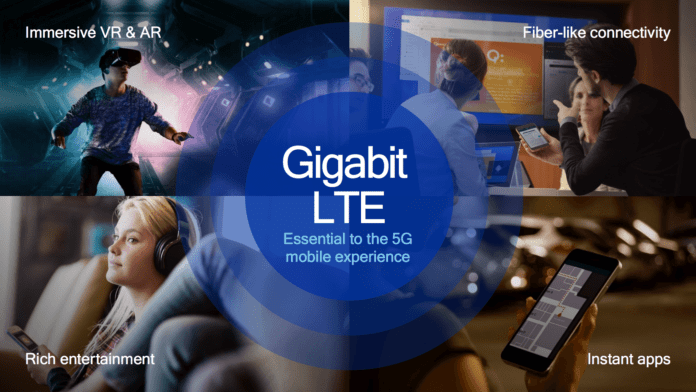Gigabit LTE creates a wireless fiber experience
Back in January, Telstra launched the world’s first gigabit LTE network in partnership with Ericsson, Qualcomm and Netgear. Based off the LTE Advanced specification, gigabit LTE networks have three fundamental building blocks: 4×4 multiple-input, multiple-output, multi-channel carrier aggregation and 256 QAM. Since Telstra’s launch, there are now 43 global operators in 25 countries in various phases of deploying the bridge technology that lays the groundwork for 5G.
Off the top, it’s important to note that gigabit LTE networks are theoretically capable of delivering gigabit-per-second mobile broadband speeds, but, in real world environments, users will see speeds in the in the 100 Mbps-plus range.
Underpinning gigabit LTE are three primary network technologies–all of which will be key to an ultimate 5G New Radio specification and subsequent commercial networks. Those are:
- 4×4 multiple-input, multiple-output (MIMO), which uses four antenna ports at the transmitter and receiver to multiply the capacity of an RF link;
- Carrier aggregation, which effectively joins together non-contiguous bits of radio spectrum, both licensed and unlicensed, into a wider channel;
- And 256 quadature amplitude modulation, a technique that manipulates waveform to allow a higher bit rate per megahertz.
Another big factor here is spectrum availability–most carriers don’t have enough licensed spectrum to deliver near-gigabit-per-second speeds without tapping into unlicensed spectrum. To that end, Licensed Assisted Access–aggregating licensed and unlicensed to create a higher capacity radio channel–is playing a key role in pushing gigabit LTE to its theoretical limit.
Earlier this year, Peter Carson, senior director of marketing, Qualcomm Technologies explained these features “are very complementary in their benefits.” Carrier aggregation “has formed the foundation of the path we’re on today. On top of that, more bits per transmission by going from 64 QAM to 256 QAM brings 33% more efficiency in the downlink.”
Carson’s colleague Sherif Hanna, staff manager, technical marketing, used a network visualization tool to show the user-level impact gigabit LTE brings not just to users with Cat 16 device, but to all network users regardless of device.
“The operators have been putting a device at the forefront” of gigabit LTE launches, Hanna said. “In each case the operator is trying to highlight a device that will give their network an edge. It’s also related to the marketing claims they can make. For the operators relying on crowd-sourced data, it is in their best interest to get these advanced devices into the hands of the users running these speed tests. It will show the network better. It is definitely in the interest of the operator to seed the devices into the network both for marketing claims and for actual capacity. Anything that can help them improve network efficiency will help them cope with network capacity related to unlimited data plans.”
To restate that, gigabit LTE has an impact on operators’ businesses that touches everything from marketing claims and device subsidization to the ability to support unlimited offerings and spectrum and network investment strategy. Essentially, more advanced devices means a better network experience for all device users.
But what exactly does availability of gigabit LTE mean for consumers? To analyze that, Qualcomm worked with Signals Research Group to highlight the benefits passed on to end users of this new breed of networks. For the purposes of understanding consumer benefit, SRG focused primarily on download speeds and video streaming. The comparison is based on a Cat 12 smartphone and the Cat 16 Samsung Galaxy S8, which uses Qualcomm’s Snapdragon 835 process and X16 modem.
A gigabit LTE device provides a 15% faster download from the Google Play store compared to the Cat 12 device in excellent network conditions and a 23% faster download time in poor network conditions. For downloading files from Google Drive, the Cat 16 device performs 20% faster in excellent network conditions and 27% faster in poor network conditions. Another key piece of the gigabit LTE puzzle is the impact of network resource usage.
In the Google Play store download scenario, the Cat 16 device uses 34% fewer network resources in excellent network conditions; in the Google Drive download scenario, the Samsung Galaxy S8 uses 30% fewer network resources. Herein lies a major driver of operator adoption of gigabit LTE–more Cat 16 devices means more network efficiencies, which equates to an improved user experience for subscribers not using a Cat 16 devices.
In a blog post, Qualcomm Senior Manager of Product Marketing Mohammed Al Khairy bullets out of the key takeaways of the analysis quoted here:
- Gigabit LTE smartphones provide better user experiences than Cat 12 smartphones:
- Faster download times
- Fewer network resources utilized
- Gigabit LTE smartphones mean virtually everyone in the network benefits
- Spectral efficiency increased by 30-40 percent
- Improved network capacity and ability to serve other users faster.
- Gigabit LTE with LAA technology provides better user experiences vs. devices that do not support LAA:
- 2x faster download speeds
- Offloads networks and increases capacity
Given the huge traction we’ve seen around gigabit LTE in 2017, expect to hear a lot more about it in the coming year.

